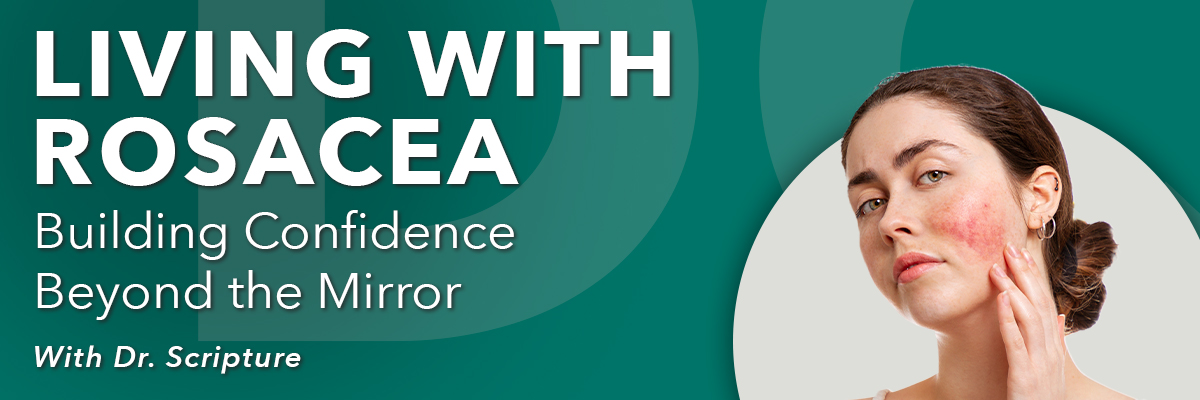
Understanding Rosacea’s Impact on Mental Health and Self-Esteem, and How a Dermatologist Can Help
Rosacea is more than just a skin condition—it can affect how people feel about themselves and how they engage with the world. For many individuals living with rosacea, visible symptoms like redness, bumps, and flushing can lead to emotional stress, lowered self-esteem, and even anxiety or depression. In this post, we explore the connection between rosacea and mental health, and how working with a dermatologist can help individuals manage symptoms and regain confidence.
The Emotional Side of Living with Rosacea
Many people living with rosacea don’t know exactly what it is or how to treat it. Rosacea causes facial redness, which can include inflammation on the cheeks, nose, chin, forehead, or eyelids, and it can be a difficult condition to live with both physically and emotionally.
According to a study conducted by American Health & Drug Benefits and published by the National Library of Medicine, rosacea can lower:
- Self-esteem
- Self-confidence
- The desire to participate in social interactions
Medical treatment for rosacea is important, and it is equally important to address the emotional impact of the condition.
How Rosacea Affects Quality of Life
There are several reasons why rosacea can impact quality of life – notably self-confidence and self-esteem:
- It is a chronic condition. Chronic conditions generally cannot be cured, and although they can be treated and managed, chronic conditions can begin to feel burdensome.
- It affects appearance. While rosacea often causes facial redness, it’s more complex than it appears. The condition can also lead to inflammation, broken blood vessels, swelling, pimples, or pustules. Because these symptoms appear on the face, they can be difficult to hide and may significantly impact self-esteem and self-confidence.
- It can get worse when left untreated. Rosacea, if left untreated with no skin care management plan, can lead to persistent facial redness, visible blood vessels, skin bumps, and in severe cases, a disfigured appearance due to thickened skin and excess tissue growth. If rosacea is affecting the eyes, failing to treat it can potentially damage the eyes and affect vision. Inadequate treatment can lead to embarrassment, social anxiety, depression, and decreased quality of life.
When a condition begins to have a negative impact on your life, it’s called a “burden of disease”; and this is an apropos description for the way certain skin issues can affect quality of life.
The National Rosacea Society reports that rosacea affects about 16 million Americans, and the actual number is likely much higher—possibly two to five times that. Because the diagnostic criteria are broad and many individuals have mild symptoms, it’s common for rosacea to go unrecognized or undiagnosed, meaning even more people may be silently experiencing its physical and emotional impact. The Dermatology Center of Indiana is committed to helping patients treat their rosacea and spreading awareness so those suffering with symptoms can finally find some relief.
Treating Rosacea and the Emotional Issues it Can Cause
Treating rosacea can prevent symptoms from worsening, help you feel more comfortable, and boost your self-confidence.
Rosacea treatment requires time and patience—it can take multiple attempts to find the right approach for each individual. It’s understandable to feel frustrated when results aren’t immediate, especially when the condition affects your appearance. But with consistent care, rosacea can be effectively managed.
In a 2022 survey by the National Rosacea Society, over 75% of patients said they’d try a new treatment for about a month, though more than half gave up after just two weeks. This highlights the importance of setting expectations and working closely with your dermatologist to stay the course and achieve long-term results.
It’s also important to note that sun protection is a key part of rosacea management. Rosacea is a complex disease influenced by both genetics and environmental triggers. One of the most significant environmental factors is sun exposure. Repeated ultraviolet (UV) exposure can worsen symptoms and accelerate rosacea flare-ups.
Daily sun protection is essential—regardless of the weather or season. Choose a mineral-based facial sunscreen and make it a consistent part of your skincare routine. It’s a simple yet powerful step in managing rosacea and protecting your skin’s overall health.
When Should You Treat Rosacea?
Treat your rosacea as soon as you begin noticing symptoms. Living with rosacea can become difficult without treatment – even if you think it’s not serious, an important part of treatment is helping you feel more confident in your appearance.
The bottom line? Rosacea is easier to treat the sooner you start, and if you’re not sure whether you have rosacea or another skin condition, it’s always best to consult with a board-certified dermatologist to get a diagnosis and treatment plan.
Having a clear plan can improve your emotional wellbeing and give you back the confidence you may have lost before you knew what was going on with your skin. I encourage anyone with rosacea – or who suspects they may have rosacea – to schedule an appointment and get on a treatment plan to restore your self-esteem and self-confidence.
Schedule an appointment at The Dermatology Center of Indiana to establish a treatment plan that will work best for you.
